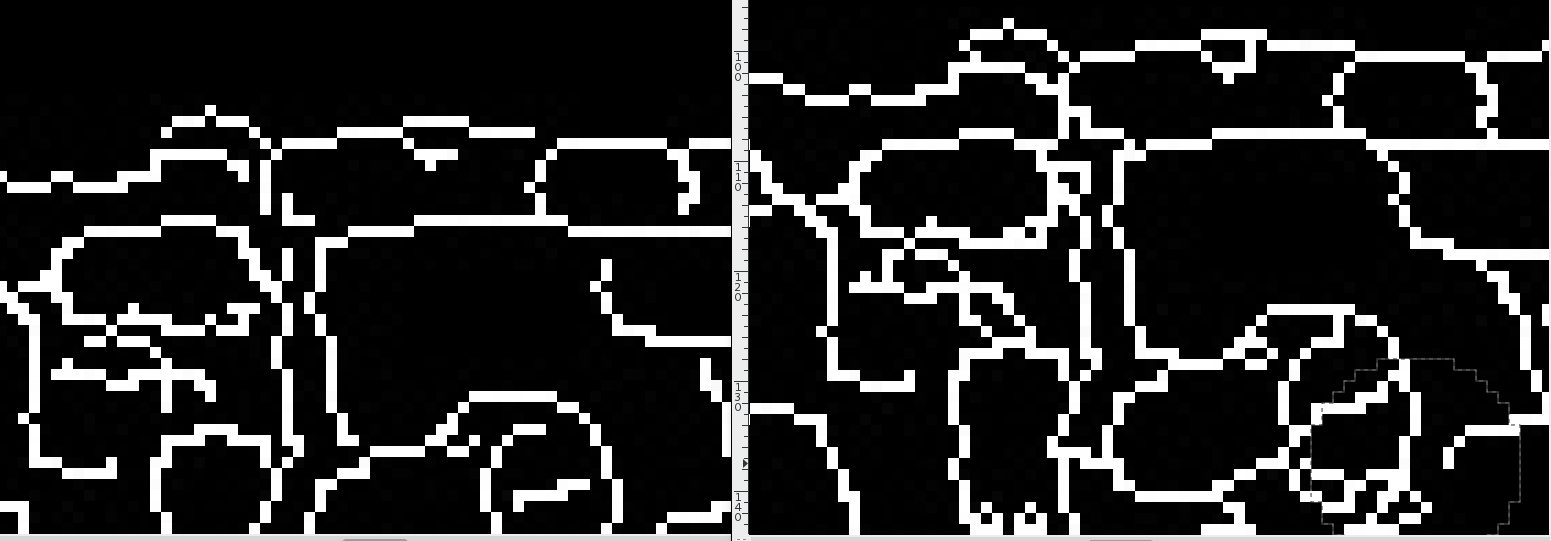This forum is disabled, please visit https://forum.opencv.org
 | 1 | initial version |
void joinEdges(Mat input){
int width=input.cols;
int height=input.rows;
const int dx[] = { 1, 1, 0, -1, -1, -1, 0, +1, 1 };
const int dy[] = { 0, 1, 1, 1, 0, -1,-1, -1, 0 };
const int d2x[] = { 2, 2, 2, 1, 0,-1,-2,-2,-2,-2,-2,-1, 0, 1, 2, 2 };
const int d2y[] = { 0, 1, 2, 2, 2, 2, 2, 1, 0,-1,-2,-2,-2,-2,-2,-1 };
const int d3x[] = { 3,3,3,3,2,1,0,-1,-2,-3,-3,-3,-3,-3,-3,-3,-2,-1,0,1,2,3,3,3 };
const int d3y[] = { 0,1,2,3,3,3,3,3,3,3,2,1,0,-1,-2,-3,-3,-3,-3,-3,-3,-3,-2,-1 };
for(int i=0;i<input.rows;i++)
for(int j=0;j<input.cols;j++){
uchar one_step,two_step,three_step;
vector<int> connection;
if(input.at<uchar>(i, j)!=0){
for (int dir = 0; dir < 8; ++dir) {
int tmp_x = j + dx[dir];
int tmp_y = i + dy[dir];
if(tmp_x < 0 || tmp_x >= width || tmp_y < 0 || tmp_y >= height ) one_step=0;//treat outside image as 0
else one_step=input.at<uchar>(tmp_y, tmp_x);
if(one_step!=0) connection.push_back(dir);
}
if(connection.size()<3 && connection.size()!=0) {
int direction1=connection.front();
int direction2=connection.back();
if(direction2-direction1<=1||direction2-direction1==7){
int start_direction=(direction2+2)*3;
int end_direction=(direction1+6)*3;
for(int dir2=start_direction;dir2<end_direction;dir2++){//dir2 is between 6~39
int tmp_1x = j + dx [dir2%24/3];
int tmp_1y = i + dy [dir2%24/3];
int tmp_2x = j + d2x[dir2%24*2/3];
int tmp_2y = i + d2y[dir2%24*2/3];
int tmp_3x = j + d3x[dir2%24];
int tmp_3y = i + d3y[dir2%24];
if(tmp_2x < 0 || tmp_2x >= width || tmp_2y < 0 || tmp_2y >= height ) two_step=0;//treat outside image as 0
else two_step=input.at<uchar>(tmp_2y, tmp_2x);
if(tmp_3x < 0 || tmp_3x >= width || tmp_3y < 0 || tmp_3y >= height ) three_step=0;//treat outside image as 0
else three_step=input.at<uchar>(tmp_3y, tmp_3x);
if (two_step!=0){
input.at<uchar>(tmp_1y, tmp_1x)=255;
break;
}else if (three_step!=0) {
input.at<uchar>(tmp_1y, tmp_1x)=255;
input.at<uchar>(tmp_2y, tmp_2x)=255;
break;
}
}
}
}
}
}
}
Just developed a piece of code to do that job,and look the result.
 Most of the loose bits are closed quite well expect for those still far from each other.Should definately keep this in the toolbox
Most of the loose bits are closed quite well expect for those still far from each other.Should definately keep this in the toolbox